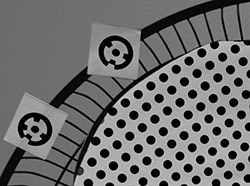- /
- /
- /
- /
Getting the Highest Possible Accuracy with Photogrammetry

If you are not doing an industrial measurement project, you may want to read How can I improve accuracy?
As the above accuracy factors page points out, some key aspects to control are camera quality, camera calibration, nature of the photography, and the ability to detect/mark points in photos precisely.
Controlling Factors for Maximum Accuracy
Camera quality
There are three factors relating to camera quality: resolution, lens quality, and stability. For maximum accuracy, you will get a camera with the highest possible resolution (before ‘fake’ high-resolution claims of some mobile phone cameras), a high-quality lens that is not too wide (ie. has a lot of lens distortion), and a camera/lens combination that is stable (ie. it does not change characteristics like focus or focal length, or CCD position as the camera is moved). Also see Recommended Camera Settings for Photogrammetry.
Camera calibration
Even with a high-quality camera, the quality of the photogrammetric calibration of that camera is key. The calibration (here we refer to internal parameters such as focal length, principal point, pixel size, and lens distortions) needs to accurately characterize the camera at the time of the project photography. Aim for low residuals and low total error in the camera calibration project and consider field calibration to ensure the parameters match the camera as it was used for the project. In most projects where accuracy is not as expected (but other factors are good), poor or mismatched camera calibration is the culprit.
Nature of the photography
For base accuracy, you will need to take photos from different angles and ensure each target dot appears in three or more photos. To improve accuracy add as many photos as is practical. The more photos you can add at different angles, the higher the accuracy will be (think of the errors being averaged out over a large sample set).
The precision of point detection in photos
For the highest accuracy, we need high precision and repeatable marking of point locations. PhotoModeler can determine the center of a contrasting circular dot to less than a pixel. Target detection is the only way to get consistently high precision in marking point locations across photographs. The picture above shows a dot grid with some Coded Targets where point location precision was needed.
As well as using dot targets for maximum marking precision, it is important to ensure the targets are imaged well. That is, ensure there is no blur from motion or focus issues, and there is good lighting, so the image noise does not reduce the ability to detect the dot edges and proper fitting. Lastly, the dot targets should not be too small or too large. Targets should be larger than 15 pixels across and smaller than 0.5% of the image size.
Summary
To get the highest possible accuracy in your photogrammetry project use high contrast target dots, use a high-resolution camera with a good lens that is stable, ensure the calibration is good (in most cases using Field Calibration), and take a good set of photos.
Absolute Accuracy
The above factors control the relative accuracy of measurement in photogrammetry. That is, how internally consistent are the measurements, but often accuracy relative to the real-world scale is also needed. Photogrammetry is scale-less until the user has entered some external reference information in terms of known points or known distances. The absolute accuracy of a project will then depend on not only the relative accuracy factors above but the accuracy of the entered scale or scales.
To improve scale accuracy ensure that the points at the end of the scale distances are marked in multiple photos at good angles and that the dots are marked well with small residuals. As well as ensure there are multiple scales, and that the scale distances are not short (should be 50% of the object size or bigger).
